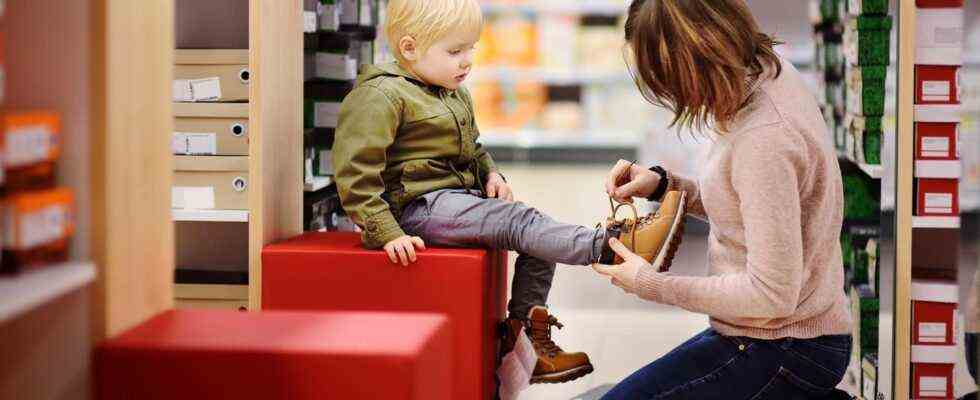Measure correctly
Children’s shoes: That’s why the right size is so important for healthy feet
The fact is that every fifth child wears shoes that are too small or too big
© SbytovaMN / Getty Images
According to the German Children’s Foot Report 2020, only every fifth child wears the wrong shoe size – a positive trend, since ten years ago significantly more children wore shoes that were too small or too big. Here you can find out why the right size is crucial for healthy feet in old age.
From the current measurements taken as part of the Children’s Foot Reports 2020 performed on 4,000 children found that 16 percent of the shoes were too small. In other words, the feet could not roll properly when walking. However, six percent of the shoes were too big, so that the feet were constricted and a natural gait was not possible. The bad thing is that children often don’t even realize they’re wearing the wrong size because their foot bones are still very soft and flexible – and therefore cause no pain. But what is even worse: Shoes that are too small or too large can promote foot malpositions that only become noticeable in old age. It is all the more important to measure children’s feet correctly and regularly.
How to measure children’s feet correctly
Children’s feet grow particularly quickly – more precisely one millimeter per month: Between the ages of three and six they can go through up to three shoe sizes. For this reason, you should measure your children’s feet regularly in the early years, preferably every six to eight weeks, and from school age every four to six months is sufficient. To find out which shoe size is right for your offspring, you can use two different methods:
Most shoe shops have a so-called foot measuring device, which can be used to determine the correct shoe size. However, if you want to order the children’s shoes online, you need to measure the feet at home – here you can easily measure your own foot gauge use one that can be bought online. It tells you the exact size, but you should always add twelve millimeters to it. So the children’s feet have enough space to roll properly in the shoes.
Alternatively, you can make your own template. All you have to do is take a piece of cardboard or a piece of paper and place your child on it with bare feet. Then take a pencil and trace the outlines of the feet. Add twelve millimeters to the longest toe, cut out the template and measure the length and width with a ruler – then you can put the template in the shoes to find out if they are big enough.
Important: Always measure children’s feet in the evening – due to the constant strain of walking and standing, they swell during the day, so that the maximum size is only reached in the evening. For the same reason, your child should always stand and not sit when taking the measurement.
Why the shoe size is not meaningful
As with clothing sizes, shoe sizes can vary in size or size depending on the brand. This is partly due to the fact that there are no fixed guidelines for how manufacturers have to measure their models. Some take the inside measurements, others the outside measurements. In addition, many brands from abroad only roughly convert their sizes in Germany, so that in this country it is not possible to rely on what is in or under the shoes. Therefore, before making any purchase, it is essential that you put your child’s shoes on once so that they can walk around in them for a few steps. This is the only way to find out quickly whether the selected size is the right one or whether it is too small or too large. A self-made template can also be useful here to determine the correct length and width.
First walkers support first steps
If your child is already trying to walk, shoes can be a useful support outdoors to stabilize the little feet (more precisely their muscles, ligaments and tendons) and to protect them from sharp objects on the ground. Apart from that, they keep children’s feet warmer longer than ordinary socks on cold autumn or winter days. On warm days, however, it makes more sense to let your child run barefoot, both indoors and outdoors (e.g. on the beach or in a meadow) – this is still the best method so that children’s feet can develop healthily if possible.
What does the abbreviation “WMS” mean?
It is not uncommon for manufacturers of children’s shoes to advertise with the title “WMS”, which simply means “width measurement system”. It not only distinguishes high-quality models, but also stands for an exact fit. In other words: every child’s shoe of the same size has the same dimensions. In addition, the relevant brands (such as Geox, Lurchi, Richter and Ricosta) advertise that their models fit particularly well on the heel and middle of the foot. On the one hand, this should make it easier to buy new children’s shoes and, on the other hand, the development of healthy feet is supported with the “WMS” award.
You might also be interested in:
This article contains so-called affiliate links. Further information are available here.

